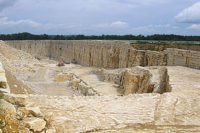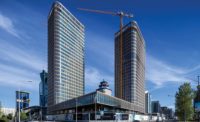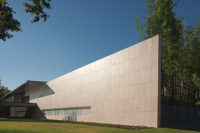“The design goal was to create an efficient super-tall office tower that was both culturally and environmentally responsive,” said Aybars Asci, Director, AIA, LEED AP of SOM. “We also aspired to create a timeless architectural icon. We did not have a preconceived idea to create a sculpted tower. The form of the tower emerged from a design process that responded to the environmental, structural and spatial parameters of the project.”
According to a design statement by SOM, “Al Hamra Tower’s profile sets it apart from other high-rise buildings and is symbolic of Kuwait’s emerging leadership in the global business industry. Its sculptural form is essentially a passive solar protection strategy. Faced with designing for brutal sun exposure, the designers chose to draw inspiration from Kuwait’s extreme desert conditions rather than concede to their constraining, if not deleterious effect.”
SOM explains that the asymmetrical form of Al Hamra Tower is generated by a simple operation of removal. “Informed by solar analyses, SOM removed one quarter of the floor plate from the south facade, initiating at the southwest corner of the tower and rotating counter-clockwise over its height,” according to the design statement. “This eliminated all south-facing office space while meeting the project’s programmatic requirements: 25,000-gross-square-foot floor plates, 40-foot lease spans and 270-degree views of the water.”
An all-stone exterior
JMS began supplying the exterior stone in May 2009 and continued until July 2010. A total of 172,000 square feet of Jura limestone — with sandblasted and brushed finishes — was employed for the building’s shell. Panels used for the lower portion of the tower measure 4 ½ x 2 ½ feet with a thickness of
40 mm, and they were installed with a support system using Fischer undercut anchors. The sculptured sides of the Al Hamra Tower are faced with 8-mm Jura limestone trencadis — a mosaic of shardlike pieces.
“The color and texture of Jura limestone were appropriate for cladding the monolithic faces of the tower,” explained Asci. “It connected well with the desert landscape, and the physical characteristics of Jura limestone make it an appropriate choice for exterior applications. We visited the quarry to identify the range of stone slabs to be used for the tower and to ensure the scale of the quarry was adequate for the job.”
Gerhard Ruf of JMS explained that a significant amount of time and effort was devoted to the project. “I started in 2007 sending the first samples, and we sent the last shipment in 2012,” he explained. “It helped a lot that we had a nice reference in Downtown Manhattan at 101 Warren Street — just a few blocks from the SOM office — where the same material (NB23/24) was installed. After a series of thorough testing, the high performance of Jura limestone was successfully proven. This was paramount for the specification for our stone in a very competitive environment.
“Later we had to send one performance mock-up to China to the facade contractor and a visual mock-up to Kuwait,” Ruf went on to explain. “We are very proud that Jura limestone is now holding the record to be the worldwide tallest building with a continuous stone facade.”
SOM explains in its design statement that the exterior stonework provides a shield against solar heat gain and acts as a heat-storing thermal mass. “The thickness of the south wall creates a thermal lag between the temperatures of the ambient air and inner wall, so that when the outside of the wall is exposed to the most severe sun, the interior wall can remain comfortably cool. Conversely, when the ambient air temperature drops, the interior wall radiates the heat it had stored over the course of the day. The south wall is punctured by a series of angled silver windows, which provides sightlines south to Kuwait City, but do not allow direct sunlight from the south to directly infiltrate the interior,” according to the design statement.
Asci explained that the cladding of the doubly curved shear walls was the most challenging aspect of the stonework. “The stone slabs are planar, whereas the concrete surface is warped, so in order to clad these shear walls, we switched from large slabs of stone to a trencadis system,” he said. “In this method, small tiles of stone are held within a mesh that is adhered directly to the substrate. This tiling method not only allowed us to clad the doubly curved surfaces seamlessly, but also gave an artisanal quality to the tower — evoking traditional Middle Eastern mosaics.”
Installing a trencadis system
When it came time to install the trencadis system on the upper part of the Al Hamra Tower, Richard Goldberg, AIA, CSI, a consulting architect with Professional Consultants International and an expert regarding direct-adhered exterior tile and stone wall cladding, was contracted to provide technical services. After evaluating the situation, it was decided that the Laticrete System® would be the most appropriate choice to install the trencadis system.
“Our engineers conducted cutting-edge computer modeling of the tile cladding assembly using finite element analysis,” explained Goldberg. “We utilized Abaqus FEA® commercial computer software — commonly used in the aerospace industry — now economically feasible in architectural building design. This software provided accurate robust simulations of the behavior of the proposed direct-adhered composite stone cladding assembly under extreme thermal expansion, concrete shrinkage and wind loading typical of the unique geographic location. Most important, this technique allowed us to confidently specify the adhesive mortar and grout products with the necessary physical properties.”
Goldberg went on to say that he and his team asked to analyze and review a number of direct-adhered stone facade installation systems. “After a highly detailed evaluation process, we selected the Laticrete System. There were many reasons, which included the quality of the products to be used, the strong warranty program which Laticrete offers, and most important, the fact that the Laticrete materials offered certified product test data of key physical characteristics which enable us to conduct computer modeling simulations.”
The trencadis limestone pieces were bonded to the exterior concrete walls of Al Hamra Tower with Laticrete 254 Platinum (white) — a one-step polymer fortified thin-set mortar. “We selected this product for many reasons, one being its high shear-bond strength and balanced shear modulus properties,” said Goldberg.
After the thin-set cured, the tiles were grouted with Laticrete 1500 Sanded Grout. Additionally, Laticrete 1776 Grout Enhancer was used in place of water to provide a dense, colorfast grout joint.
Interior stonework
For the interior of the Al Hamra Tower, JMS furnished approximately 645,000 square feet of Jura limestone. The quarry producer began supplying the stone for the interior design in November of 2008 and continued through July 2011.
While Jura Beige with a polished finish was employed for the floors of the ground floor lobby, sky lobby and elevator lobby, the interior core walls are clad in Jura Vein Cut with brushed finish. The German limestone contributes to the overall elegant feel of the interior space.
Asci said that it took six years to build the Al Hamra Tower. “The client is very happy with their building,” he said. “In Kuwait, the tower instantly became an icon for the city. The tower has received many international design awards, and has been published in numerous magazines and books. In 2011, Timemagazine listed it as one of their 50 best inventions of the year, which is quite an accomplishment for a building.”












